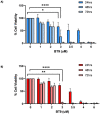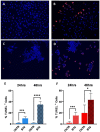This is a preprint.
Preclinical assessment of MAGMAS inhibitor as a potential therapy for pediatric medulloblastoma
- PMID: 38464047
- PMCID: PMC10925277
- DOI: 10.1101/2024.02.29.582709
Preclinical assessment of MAGMAS inhibitor as a potential therapy for pediatric medulloblastoma
Update in
-
Preclinical assessment of MAGMAS inhibitor as a potential therapy for pediatric medulloblastoma.PLoS One. 2024 Oct 22;19(10):e0300411. doi: 10.1371/journal.pone.0300411. eCollection 2024. PLoS One. 2024. PMID: 39436961 Free PMC article.
Abstract
Medulloblastoma, the most common pediatric brain malignancy, has Sonic Hedgehog (SHH) and non-SHH group3 subtypes. MAGMAS (Mitochondrial Associated Granulocyte Macrophage colony-stimulating factor Signaling molecules) encode for mitochondrial import inner membrane translocase subunit and is responsible for translocation of matrix proteins across the inner membrane. We previously reported that a small molecule MAGMAS inhibitor, BT9, decreases cell proliferation, migration, and oxidative phosphorylation in adult glioblastoma cell lines. The aim of our study was to investigate whether the chemotherapeutic effect of BT9 can be extended to pediatric medulloblastoma.
Methods: Multiple in vitro assays were performed using human DAOY (SHH activated tp53 mutant) and D425 (non-SHH group 3) cells. The impact of BT9 on cellular growth, death, migration, invasion, and metabolic activity were quantified using MTT assay, TUNEL staining, scratch wound assay, Matrigel invasion chambers, and seahorse assay, respectively. Survival following 50mg/kg BT9 treatment was assessed in vivo in immunodeficient mice intracranially implanted with D425 cells.
Results: Compared to control, BT9 treatment led to a significant reduction in medulloblastoma cell growth (DAOY, 24hrs IC50: 3.6uM, 48hrs IC50: 2.3uM, 72hrs IC50: 2.1uM; D425 24hrs IC50: 3.4uM, 48hrs IC50: 2.2uM, 72hrs IC50: 2.1uM) and a significant increase in cell death (DAOY, 24hrs p=0.0004, 48hrs p<0.0001; D425, 24hrs p=0.0001, 48hrs p=0.02). In DAOY cells, 3uM BT9 delayed migration, and significantly decreased DAOY and D425 cells invasion (p < 0.0001). Our in vivo study, however, did not extend survival in xenograft mouse model of group3 medulloblastoma compared to vehicle-treated controls.
Conclusions: Our in vitro data showed BT9 antitumor efficacy in DAOY and D425 cell lines suggesting that BT9 may represent a promising targeted therapeutic in pediatric medulloblastoma. These data, however, need to be further validated in animal models.
Figures






References
-
- Juraschka K. and Taylor M.D., Medulloblastoma in the age of molecular subgroups: a review. J Neurosurg Pediatr, 2019. 24(4): p. 353–363. - PubMed
Publication types
Grants and funding
LinkOut - more resources
Full Text Sources
Research Materials
Miscellaneous
